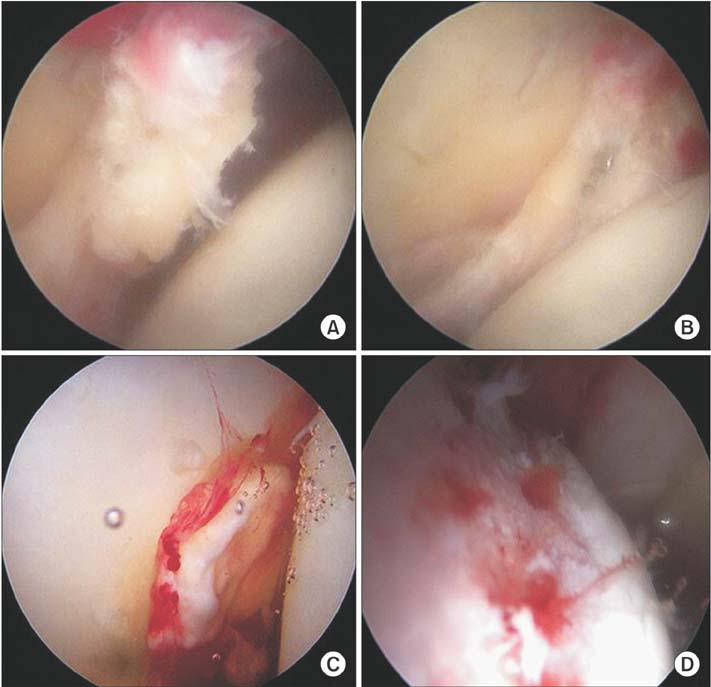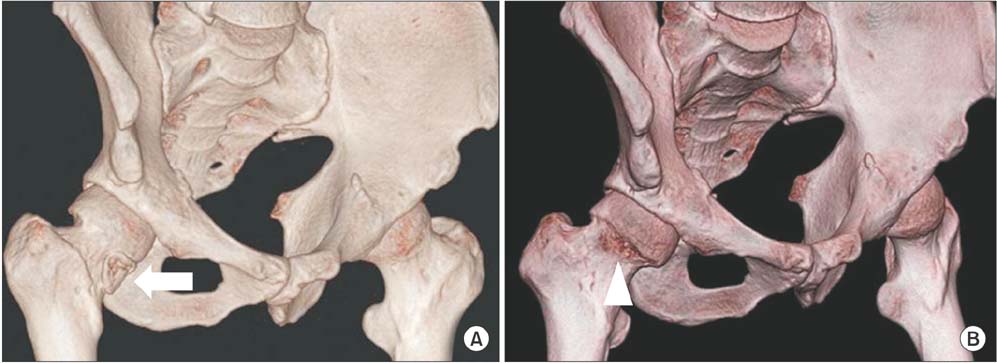Clin Orthop Surg.
2015 Dec;7(4):443-448. 10.4055/cios.2015.7.4.443.
Usefulness of Arthroscopic Treatment of Painful Hip after Acetabular Fracture or Hip Dislocation
- Affiliations
-
- 1Department of Orthopaedic Surgery, Hallym University Chuncheon Sacred Heart Hospital, Hallym University College of Medicine, Chuncheon, Korea.
- 2Department of Orthopaedic Surgery, Chungnam National University School of Medicine, Daejeon, Korea. dshwang@cnu.ac.kr
- 3Department of Orthopaedic Surgery, Yanbian University School of Medicine, Yanji, China.
- KMID: 2360257
- DOI: http://doi.org/10.4055/cios.2015.7.4.443
Abstract
- BACKGROUND
Painful hip following hip dislocation or acetabular fracture can be an important signal for early degeneration and progression to osteoarthritis due to intraarticular pathology. However, there is limited literature discussing the use of arthroscopy for the treatment of painful hip. The purpose of this retrospective study was to analyze the effectiveness and benefit of arthroscopic treatment for patients with a painful hip after major trauma.
METHODS
From July 2003 to February 2013, we reviewed 13 patients who underwent arthroscopic treatment after acetabular fracture or hip dislocation and were followed up for a minimum of 2 postoperative years. The degree of osteoarthritis based on the Tonnis classification pre- and postoperatively at final follow-up was determined. Clinical outcomes were evaluated using visual analogue scale for pain (VAS) and modified Harris hip score (MHHS), and range of motion (ROM) of the hip pre- and postoperatively at final follow-up.
RESULTS
There were nine male and four female patients with a mean age at surgery of 28 years (range, 20 to 50 years). The mean follow-up period of the patients was 59.8 months (range, 24 to 115 months), and the mean interval between initial trauma and arthroscopic treatment was 40.8 months (range, 1 to 144 months). At the final follow-up, VAS and MHHS improved significantly from 6.3 and 53.4 to 3.0 and 88.3, respectively (p = 0.002 and p < 0.001, respectively). However, there were no significant differences in hip flexion, abduction, adduction, external rotation, and internal rotation as minor improvements from 113.1°, 38.5°, 28.5°, 36.5°, and 22.7° to 118.5°, 39.0°, 29.2°, 38.9°, and 26.5° were observed, respectively (p = 0.070, p = 0.414, p = 0.317, p = 0.084, and p = 0.136, respectively). None of the patients exhibited progression of osteoarthritis of the hip at the final follow-up.
CONCLUSIONS
Arthroscopic treatment after acetabular fracture or hip dislocation is effective and delays the progression of traumatic osteoarthritis.
Keyword
MeSH Terms
Figure
Cited by 1 articles
-
Effectiveness of Hip Arthroscopy Performed Simultaneously before Open Reduction and Internal Fixation for Acetabular Fracture and Fracture-dislocation of the Hip
Hyeon Jun Kim, Sung Soo Kim, Young Hun Jung, Kyung Ho Lee
Hip Pelvis. 2018;30(2):92-100. doi: 10.5371/hp.2018.30.2.92.
Reference
-
1. Larson CM, Guanche CA, Kelly BT, Clohisy JC, Ranawat AS. Advanced techniques in hip arthroscopy. Instr Course Lect. 2009; 58:423–436.2. Wagner S, Hofstetter W, Chiquet M, et al. Early osteoarthritic changes of human femoral head cartilage subsequent to femoro-acetabular impingement. Osteoarthritis Cartilage. 2003; 11(7):508–518.
Article3. Ganz R, Parvizi J, Beck M, Leunig M, Notzli H, Siebenrock KA. Femoroacetabular impingement: a cause for osteoarthritis of the hip. Clin Orthop Relat Res. 2003; (417):112–120.4. Beck M, Kalhor M, Leunig M, Ganz R. Hip morphology influences the pattern of damage to the acetabular cartilage: femoroacetabular impingement as a cause of early osteoarthritis of the hip. J Bone Joint Surg Br. 2005; 87(7):1012–1018.5. Sutter R, Zanetti M, Pfirrmann CW. New developments in hip imaging. Radiology. 2012; 264(3):651–667.
Article6. Aprato A, Jayasekera N, Bajwa A, Villar RN. Peri-articular diseases of the hip: emerging frontiers in arthroscopic and endoscopic treatments. J Orthop Traumatol. 2014; 15(1):1–11.
Article7. Bagaria V, Sapre V. Arthroscopic removal of intraarticular fragments following fracture dislocation of the hip. Indian J Orthop. 2008; 42(2):225–227.
Article8. Byrd JW, Jones KS. Traumatic rupture of the ligamentum teres as a source of hip pain. Arthroscopy. 2004; 20(4):385–391.
Article9. Foulk DM, Mullis BH. Hip dislocation: evaluation and management. J Am Acad Orthop Surg. 2010; 18(4):199–209.
Article10. Philippon MJ, Kuppersmith DA, Wolff AB, Briggs KK. Arthroscopic findings following traumatic hip dislocation in 14 professional athletes. Arthroscopy. 2009; 25(2):169–174.
Article11. Svoboda SJ, Williams DM, Murphy KP. Hip arthroscopy for osteochondral loose body removal after a posterior hip dislocation. Arthroscopy. 2003; 19(7):777–781.
Article12. Yamamoto Y, Ide T, Ono T, Hamada Y. Usefulness of arthroscopic surgery in hip trauma cases. Arthroscopy. 2003; 19(3):269–273.
Article13. Ilizaliturri VM Jr, Gonzalez-Gutierrez B, Gonzalez-Ugalde H, Camacho-Galindo J. Hip arthroscopy after traumatic hip dislocation. Am J Sports Med. 2011; 39:Suppl. 50S–57S.
Article14. Clegg TE, Roberts CS, Greene JW, Prather BA. Hip dislocations: epidemiology, treatment, and outcomes. Injury. 2010; 41(4):329–334.
Article15. Kashiwagi N, Suzuki S, Seto Y. Arthroscopic treatment for traumatic hip dislocation with avulsion fracture of the ligamentum teres. Arthroscopy. 2001; 17(1):67–69.
Article16. Mullis BH, Dahners LE. Hip arthroscopy to remove loose bodies after traumatic dislocation. J Orthop Trauma. 2006; 20(1):22–26.
Article17. Tonnis D. Normal values of the hip joint for the evaluation of X-rays in children and adults. Clin Orthop Relat Res. 1976; (119):39–47.18. Kang C, Hwang DS, Cha SM. Acetabular labral tears in patients with sports injury. Clin Orthop Surg. 2009; 1(4):230–235.
Article19. Wilkin G, March G, Beaule PE. Arthroscopic acetabular labral debridement in patients forty-five years of age or older has minimal benefit for pain and function. J Bone Joint Surg Am. 2014; 96(2):113–118.
Article20. Ayeni OR, Levy BA, Musahl V, Safran MR. Current state-of-the-art of hip arthroscopy. Knee Surg Sports Traumatol Arthrosc. 2014; 22(4):711–713.
Article21. Stevens MS, Legay DA, Glazebrook MA, Amirault D. The evidence for hip arthroscopy: grading the current indications. Arthroscopy. 2010; 26(10):1370–1383.
Article22. Byrd JW. Labral lesions: an elusive source of hip pain case reports and literature review. Arthroscopy. 1996; 12(5):603–612.
Article23. Ide T, Akamatsu N, Nakajima I. Arthroscopic surgery of the hip joint. Arthroscopy. 1991; 7(2):204–211.
Article24. Kelley B, Anderson R, Miles K. Acetabular labrum tear in a 15-year-old male: diagnosis with correlative imaging. Australas Radiol. 1997; 41(2):157–159.
Article25. Letournel E. Acetabulum fractures: classification and management. Clin Orthop Relat Res. 1980; (151):81–106.
Article26. Matta JM, Anderson LM, Epstein HC, Hendricks P. Fractures of the acetabulum: a retrospective analysis. Clin Orthop Relat Res. 1986; (205):230–240.27. Stewart MJ, McCarroll HR Jr, Mulhollan JS. Fracture-dislocation of the hip. Acta Orthop Scand. 1975; 46(3):507–525.28. Fitzgerald RH Jr. Acetabular labrum tears: diagnosis and treatment. Clin Orthop Relat Res. 1995; (311):60–68.
- Full Text Links
- Actions
-
Cited
- CITED
-
- Close
- Share
- Similar articles
-
- Arthroscopic Removal of the Intraarticular Fracture Fragment after Internal Fixation of Acetabular Fracture: A Case Report
- Hip Arthroscopy for Incarcerated Acetabular Labrum following Reduction of Traumatic Hip Dislocation: Three Case Reports
- Effectiveness of Hip Arthroscopy Performed Simultaneously before Open Reduction and Internal Fixation for Acetabular Fracture and Fracture-dislocation of the Hip
- Intertrochanteric fracture associated with posterior hip dislocation
- Traumatic Recurrent Dislocation of the Hip with Bankart Type Lesion: A Case Report



